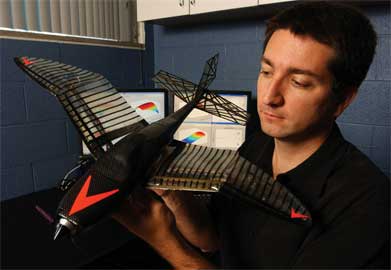|
|
It's A Bird! It's A Plane!downloadable pdfThe military's next generation of airborne drones won't be just small and silent - they'll also dive between buildings, zoom under overpasses and land on apartment balconies. “Nothing personal, but the only state with more wild hogs than Florida is Texas,” said Bill Giuliano, an assistant professor of wildlife ecology at the University of Florida’s Institute of Food and Agricultural Sciences. Wild or feral hogs can now be found in every Florida county and in at least 35 states — including 1 to 2 million hogs in the Southeast. Nationwide, their population totals about 3 million.
Funded by the U.S. Air Force and NASA, UF aerospace engineers have built prototypes of 6-inch- to 2-foot drones capable of squeezing in and out of tight spots in cities — like tiny urban stunt planes. Their secret: seagull-inspired wings that “morph,” or change shape, dramatically during flight, transforming the planes’ stability and agility at the touch of a button on the operator’s remote control. “If you fly in the urban canyon, through alleys, around parking garages and between buildings, you need to do sharp turns, spins and dives,” said Rick Lind, a UF assistant professor of mechanical and aerospace engineering who heads the project. “That means you need to change the shape of the aircraft during flight.” The Air Force’s Predator Unmanned Aerial Vehicle and other military drones have been key to military operations in Iraq and Afghanistan. But the drones, which shoot surveillance images and sometimes also fire missiles, are designed to soar high above the landscape. That limits their ability to snoop up close in the windows, alleys, corners and other urban crevices of the tight neighborhoods that define many cities, Lind said. The UF planes are intended to correct this deficiency and add new capabilities, such as landing in tight spots during a mission. That could be useful, for example, if the planes, equipped with sensors for biological or chemical weapons, were investigating single buildings where the weapons were suspected of being made, Lind said. Lind came to UF in 2001 from NASA, where one of his last projects involved modifying the wings of an F-18 fighter to change shape during flight. He drew on this research for the drones, but he also had another source of inspiration: the Wright brothers’ first plane. As Lind noted, unlike later planes, the wings of that biplane had no flaps, or ailerons. Instead, the brothers controlled the plane’s roll by using cables to twist the shape of the wings up and down during flight. Birds also change wing shape. “Birds morph all the time, and they’re very agile,” Lind said. “There’s no reason we can’t achieve the same control that birds achieve.” Doctoral student Mujahid Abdulrahim, who built the prototype, photographed seagulls close-up during flight and saw the gulls’ wings flexing at both their shoulder and elbow joints as they altered flight patterns. When Abdulrahim added this ability to the new prototype he got promising results. With the wings mimicking the gulls’ elbow in the down position, the plane loses stability but becomes highly maneuverable. With the wings in the elbow straight position, it glides well. And with the wings in the elbow up position, it’s highly controllable and easy to land. Motors can transform the wings from the down to the up position in flight in 12 seconds, “fast enough to use in a city landscape,” Abdulrahim said. The bird-like prototypes are strikingly maneuverable, capable, for example, of completing three, 360-degree rolls in one second. (An F-16 fighter jet can manage at least one roll per second, but three rolls would produce excessive gravity force, killing the pilot.) Flying in videotaped demonstrations, they are so agile they appear out of control at times, and indeed the planes require considerable talent by the remote control pilot. The Air Force and NASA have so far provided about $3 million for the UF research, a substantial portion of which is aimed at addressing that issue by making the planes easier to fly. The engineers’ goal is to make the planes autonomous, or flyable without human pilots. That won’t be easy, but it would give the planes remarkable utility. ”If the vehicle can search an area by itself, you have almost instantaneous response to what’s being threatened,” Lind said. Rick Lind, ricklind@ufl.edu Aaron Hoover
|

